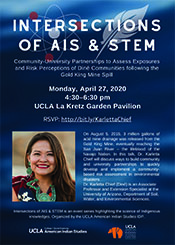Community-University Partnerships to Assess Exposures and Risk Perceptions of Diné Communities following the Gold King Mine Spill
 Monday, April 27, 2020
Monday, April 27, 2020
4:30–6:30 PM
La Kretz Garden Pavilion
RSVP: http://bit.ly/KarlettaChief
Intersections of AIS & STEM presents "Community-University Partnerships to Assess Exposures and Risk Perceptions of Diné Communities following the Gold King Mine Spill," a talk by Dr. Karletta Chief (Diné).
On August 5, 2015, 3 million gallons of acid mine drainage was released from the Gold King Mine, eventually reaching the San Juan River - the lifeblood of the Navajo Nation. In this talk, Dr. Karletta Chief will discuss ways to build community and university partnerships to quickly develop and implement a community-based risk assessment in environmental disasters. Central to this effort has been the development of a network of Diné community partners from the affected chapters that have guided the university researchers in designing and implementing a culturally appropriate study that addresses the community’s concerns. A key focus has been on building capacity for assessing environmental exposures through training of Diné tribal college students, environmental interns, and community health representatives. To date nearly a hundred students (half Diné) and 25 community members have collaborated and participated in data collection, interpretation, and dissemination. Given the potential for future catastrophic mine spills in the Western United States, findings will be used to develop a model of community capacity-building aimed at empowering affected communities to collect samples, minimize impacts, and engage in informed-decision making.
Dr. Karletta Chief (Diné) is an Associate Professor and Specialist in Soil, Water, and Environmental Sciences at the University of Arizona (UA). Her research focuses on understanding, tools, and predictions of watershed hydrology, unsaturated flow in arid environments, and how natural and human disturbances impact water resources. As an extension specialist, she works to bring relevant science to Native American communities in a culturally sensitive manner by providing hydrology expertise, transferring knowledge, assessing information needs, and developing applied science projects. Dr. Chief is a member of a national climate change network of indigenous and non-indigenous scientists. Two of her primary tribal projects are The Pyramid Lake Paiute Tribe Climate Adaptation and Traditional Knowledge and The Navajo Nation Gold King Mine Spill Impacts. Dr. Chief is the PI of the National Science Foundation Training Track “Indigenous Food, Energy, and Water Security and Sovereignty” where 12 graduate trainees are learning FEWS skills and how to work with indigenous communities. Dr. Chief is Diné from Black Mesa, AZ and was raised without electricity or running water. She is a first generation college graduate. Dr. Chief received a B.S. and M.S. in Civil and Environmental Engineering from Stanford University in 1998 and 2000 and a Ph.D. in Hydrology and Water Resources from UA in 2007. She completed her post-doctorate at Desert Research Institute in Las Vegas, NV. In 2011, Dr. Chief was named American Indian Science and Engineering Society (AISES) Most Promising Scientist/Scholar, 2013 Stanford University Distinguished Alumni Scholar award, 2015 Native American 40 under 40, 2016 AISES Professional of the Year, and 2016 Phoenix Indian Center Woman of the Year.
Intersections of AIS & STEM is an event series highlighting the science of Indigenous knowledges.
Organized by the UCLA American Indian Studies IDP. Co-sponsored by the UCLA American Indian Studies Center.
UCLA is a tobacco-free campus. All-day parking ($13) and short-term parking (payable at pay stations) are available in Lots 2, 3 and 4 (enter the campus at Hilgard and Westholme avenues). For more information, call 310-825-7315.






